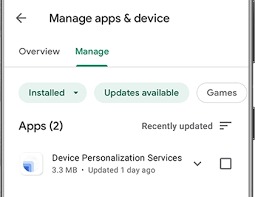Managing apps involves tracking installed apps, updating them regularly, organising them for easy access, monitoring storage and security, managing permissions, backing up data, removing unused apps, optimising performance, and gathering user feedback for improvement.
Here are some key points to managing Apps:
- Inventory: Keep track of all installed apps.
- Updates: Regularly check for and install app updates.
- Organisation: Group apps by category or usage.
- Storage: Monitor and manage app storage usage.
- Security: Ensure apps are from trusted sources and update security settings.
- Permissions: Review and manage app permissions.
- Backups: Backup app data to prevent loss.
- Uninstallation: Remove unused or unwanted apps to free up space.
- Performance: Monitor app performance and troubleshoot issues.
- Feedback: Gather user feedback to improve the app experience.
Effective app management enhances device performance, security, and user experience.
What is the use of Updating Apps?
Updating apps serves several vital purposes in mobile technology. Updates mainly include bug fixes and performance improvements, addressing issues that may have been discovered since the app’s initial release. These fixes enhance the stability and performance of the app, ensuring a smoother user experience. Additionally, app updates frequently introduce new features, functionalities, and enhancements based on user feedback. This continuous evolution keeps the app relevant, competitive, and aligned with changing user needs and preferences. Moreover, updates often include security patches to address and protect user data from potential threats. By regularly updating apps, users can ensure that they benefit from the latest improvements, features, and security enhancements, thus maximising the utility and safety of their mobile experience.
How do I Update Apps?
You can install your app in an auto update to quickly get timely updates. This option is available on your app store or Play Store.
To update apps on your device, follow these general steps:
- Open App Store or Play Store: Launch the respective app store on your device. (AppStore for IOS devices and Play Store for Android devices).
- Navigate to the Updates Section: Look for the “Updates” tab or section within the app store. This section typically displays a list of available updates for your installed apps.
- Check for Updates: Tap on the “Updates” tab for your installed apps.
- Update Individual App: Scroll through the list and locate the app(s) you want to update. Click on the “Update” button next to each app to initiate the update process for that specific app.
- Update All Apps: You may also have the option to update all apps simultaneously. Look for an “Update All” button or similar option at the top or bottom of the updates list.
- Follow Prompts: Follow any on-screen prompts or instructions to complete the update process. Depending on your device settings, you may need to enter your passcode or authenticate with your fingerprint or Face ID.
- Wait for Installation: Once you’ve initiated the updates, the app store will download or install the latest versions of the selected apps. The progress of each update will be displayed on-screen.
- Completion: Once the updates are successfully installed, you’ll typically see a message confirming the completion of the update process. You can then close the app store and use your updated apps as usual.
APK optimisation and performance:
APK optimisation plays a crucial role in enhancing the performance of Android applications. Developers employ various techniques to streamline the size of APK files, reduce resource consumption, and improve overall efficiency. This optimisation process often involves code minification, removing redundant or unnecessary code to reduce the app’s footprint. Additionally, developers may utilise resource optimisation techniques to compress images, audio, and other assets within the APK, minimising file size without compromising quality. Furthermore, optimizing app loading times and runtime performance through efficient coding practices and resource management can significantly enhance user experience. By prioritising optimisation, developers ensure that their APKs deliver smooth and responsive performance across a wide range of Android devices, ultimately leading to higher user satisfaction and engagement.

Techniques for optimising APK size:
You can employ various strategies to optimise the size of your APK (Android Application Package). First, eliminate unused resources and code, ensuring that your app only includes what’s necessary. Compressing images and media files helps reduce their size without compromising quality. APK splitting allows you to create separate APKs tailored to specific device configurations, reducing overall file size. Choose lightweight libraries and dependencies and configure resources efficiently for different device configurations. Utilise ProGuard or R8 for code shrinking and obfuscation. Lazy-loading resources and assets delays their loading until needed, further reducing initial APK size. Compress assets and resources using efficient compression algorithms. Optimise APK packaging by removing unnecessary files and optimising compression. Finally, consider using the Android App Bundle format for automatic APK splitting and optimisation based on device configurations, further reducing APK size. These techniques collectively ensure a smaller APK size, resulting in faster downloading and improved user experiences.
In brief, here are techniques for optimising APK size:
- Remove unused resources and code.
- Compress images and media files.
- Use APK splitting for device-specific configurations.
- Optimise libraries and dependencies.
- Configure resources efficiently.
- Enable ProGuard or R8 code shrinking.
- Lazy-load resources and assets.
- Compress assets and resources.
- Optimise APK packaging.
- Utilise Android App Bundle (AAB) format for automatic APK splitting and optimisation.
Feature Enhancement: Updates often bring new features, functionalities, and improvements, enriching the user experience and providing additional utility.
- Bug Fixes: Developers address issues and bugs identified in previous versions, ensuring smoother operation and stability.
- Security Enhancements: Updates frequently include patches for security vulnerabilities, protecting users from potential threats and attacks.
- Compatibility: Keeping apps updated ensures they remain compatible with the latest operating system versions, device hardware, and APIs, preventing compatibility issues and performance degradation.
- Performance Optimization: Developers may optimise app performance, speed, and efficiency through updates, ensuring a smoother and more responsive user experience.
- User Satisfaction: Regular updates demonstrate the developer’s commitment to improving the app, enhancing user satisfaction, and fostering loyalty among the user base.
If you want such an APK file for a lot of entertainment such as movies, TV Shows & Vpns etc, then click on SimontokApk
Frequently asked questions:
Can someone prevent app updates on a work profile?
If you’re an employee and want to prevent app updates on your work profile, consult your IT department or refer to your organisation’s device management policies. They might have configured settings that either allow or restrict users from updating apps within work profiles for security or compliance reasons.
Can someone choose which version of an app to install?
In most cases, the ability to choose which version of an app to install depends on the app distribution platform and the policies set by the platform and the app developer.
On some platforms, like the Google Play Store or App Store, users typically have limited control over which version of an app to install. These platforms generally provide only the latest version for download or update.
Can I turn off updates for the Google Play Store and Google Play Services?
Unfortunately, you can’t directly turn off updates for Google Play Services as it’s essential to properly functioning various apps. However, for the Google Play Store, you can prevent automatic updates by going to settings, selecting “Auto-update apps,” and choosing “Don’t auto-update apps.” This gives you control over when app updates are installed.
What should I do if Google Play Services is draining my battery?
Try restarting your device, clearing the cache for Google Play Services, or updating to the latest version to address any potential issues.
How do I troubleshoot Google Play Services errors?
To troubleshoot Google Play Services errors, start by restarting your device and ensuring that Google Play Services is up-to-date through the Google Play Store. Clear the cache and data of Google Play Services in the device settings, and check that your device date and time setting are correct. Removing and re-adding your Google account can also help resolve issues. Additionally, ensure a stable internet connection and update your device’s operating system if available. If the problem persists, consider performing a factory reset, but remember to back up your data first. If the issue persists, seek further assistance from Google Support or your device manufacturer.

